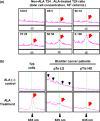Diagnostic approach for cancer cells in urine sediments by 5-aminolevulinic acid-based photodynamic detection in bladder cancer
- PMID: 24602011
- PMCID: PMC4317833
- DOI: 10.1111/cas.12393
Diagnostic approach for cancer cells in urine sediments by 5-aminolevulinic acid-based photodynamic detection in bladder cancer
Abstract
Bladder urothelial carcinoma is diagnosed and followed up after transurethral resection using a combination of cystoscopy, urine cytology and urine biomarkers at regular intervals. However, cystoscopy can overlook flat lesions like carcinoma in situ, and the sensitivity of urinary tests is poor in low-grade tumors. There is an emergent need for an objective and easy urinary diagnostic test for the management of bladder cancer. In this study, three different modalities for 5-aminolevulinic acid (ALA)-based photodynamic diagnostic tests were used. We developed a compact-size, desktop-type device quantifying red fluorescence in cell suspensions, named "Cellular Fluorescence Analysis Unit" (CFAU). Urine samples from 58 patients with bladder cancer were centrifuged, and urine sediments were then treated with ALA. ALA-treated sediments were subjected to three fluorescence detection assays, including the CFAU assay. The overall sensitivities of conventional cytology, BTA, NMP22, fluorescence cytology, fluorescent spectrophotometric assay and CFAU assay were 48%, 33%, 40%, 86%, 86% and 87%, respectively. Three different ALA-based assays showed high sensitivity and specificity. The ALA-based assay detected low-grade and low-stage bladder urothelial cells at shigher rate (68-80% sensitivity) than conventional urine cytology, BTA and NMP22 (8-20% sensitivity). Our findings demonstrate that the ALA-based fluorescence detection assay is promising tool for the management of bladder cancer. Development of a rapid and automated device for ALA-based photodynamic assay is necessary to avoid the variability induced by troublesome steps and low stability of specimens.
Keywords: 5-Aminolevulinic acid; bladder cancer; fluorescence; urine biomarker; urine cytology.
© 2014 The Authors. Cancer Science published by Wiley Publishing Asia Pty Ltd on behalf of Japanese Cancer Association.
Figures






Similar articles
-
Spectrophotometric photodynamic detection involving extracorporeal treatment with hexaminolevulinate for bladder cancer cells in voided urine.J Cancer Res Clin Oncol. 2017 Nov;143(11):2309-2316. doi: 10.1007/s00432-017-2476-5. Epub 2017 Jul 19. J Cancer Res Clin Oncol. 2017. PMID: 28726046 Free PMC article.
-
High diagnostic efficacy of 5-aminolevulinic acid-induced fluorescent urine cytology for urothelial carcinoma.Int J Clin Oncol. 2019 Sep;24(9):1075-1080. doi: 10.1007/s10147-019-01447-5. Epub 2019 Apr 11. Int J Clin Oncol. 2019. PMID: 30976938
-
[Fluorescence cytology of the urinary bladder].Urologe A. 2001 May;40(3):217-21. doi: 10.1007/s001200050465. Urologe A. 2001. PMID: 11405131 German.
-
Diagnostic Advances in Urine Cytology.Surg Pathol Clin. 2018 Sep;11(3):601-610. doi: 10.1016/j.path.2018.06.001. Epub 2018 Jul 13. Surg Pathol Clin. 2018. PMID: 30190143 Review.
-
Urine cytology in bladder tumors.Int Surg. 1991 Jan-Mar;76(1):52-4. Int Surg. 1991. PMID: 2045253 Review.
Cited by
-
5-Aminolevulinic acid overcomes hypoxia-induced radiation resistance by enhancing mitochondrial reactive oxygen species production in prostate cancer cells.Br J Cancer. 2022 Jul;127(2):350-363. doi: 10.1038/s41416-022-01789-4. Epub 2022 Apr 1. Br J Cancer. 2022. PMID: 35365766 Free PMC article.
-
Emerging biomarkers for the diagnosis and monitoring of urothelial carcinoma.Res Rep Urol. 2018 Dec 14;10:251-261. doi: 10.2147/RRU.S173027. eCollection 2018. Res Rep Urol. 2018. PMID: 30588457 Free PMC article. Review.
-
Detection of bladder cancer using voided urine sample and by targeting genomic VPAC receptors.Indian J Urol. 2021 Oct-Dec;37(4):345-349. doi: 10.4103/iju.iju_132_21. Epub 2021 Oct 1. Indian J Urol. 2021. PMID: 34759527 Free PMC article.
-
Novel laser therapies and new technologies in the endoscopic management of upper tract urothelial carcinoma: a narrative review.Transl Androl Urol. 2023 Nov 30;12(11):1723-1731. doi: 10.21037/tau-23-56. Epub 2023 Nov 15. Transl Androl Urol. 2023. PMID: 38106677 Free PMC article. Review.
-
Fluorescence-based discrimination of breast cancer cells by direct exposure to 5-aminolevulinic acid.Cancer Med. 2019 Sep;8(12):5524-5533. doi: 10.1002/cam4.2466. Epub 2019 Aug 5. Cancer Med. 2019. PMID: 31385432 Free PMC article.
References
-
- Xylinas E, Kluth LA, Rieken M, Karakiewicz PI, Lotan Y, Shariat SF. Urine markers for detection and surveillance of bladder cancer. Urol Oncol. 2014;32:222–9. - PubMed
-
- Rink M, Babjuk M, Catto JW, et al. Hexyl aminolevulinate-guided fluorescence cystoscopy in the diagnosis and follow-up of patients with non-muscle-invasive bladder cancer: a critical review of the current literature. Eur Urol. 2013;64:624–38. - PubMed
-
- Burger M, Grossman HB, Droller M, et al. Photodynamic diagnosis of non-muscle-invasive bladder cancer with hexaminolevulinate cystoscopy: a meta-analysis of detection and recurrence based on raw data. Eur Urol. 2013;64:846–54. - PubMed
-
- Miyake M, Ishii M, Kawashima K, et al. siRNA-mediated knockdown of the heme synthesis and degradation pathways: modulation of treatment effect of 5-aminolevulinic acid-based photodynamic therapy in urothelial cancer cell lines. Photochem Photobiol. 2009;85:1020–7. - PubMed
Publication types
MeSH terms
Substances
LinkOut - more resources
Full Text Sources
Other Literature Sources
Medical
Research Materials
Miscellaneous

